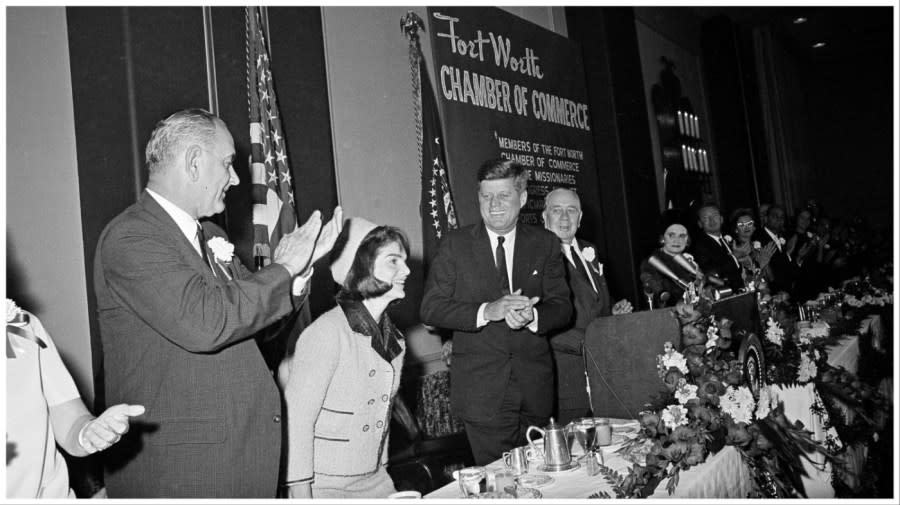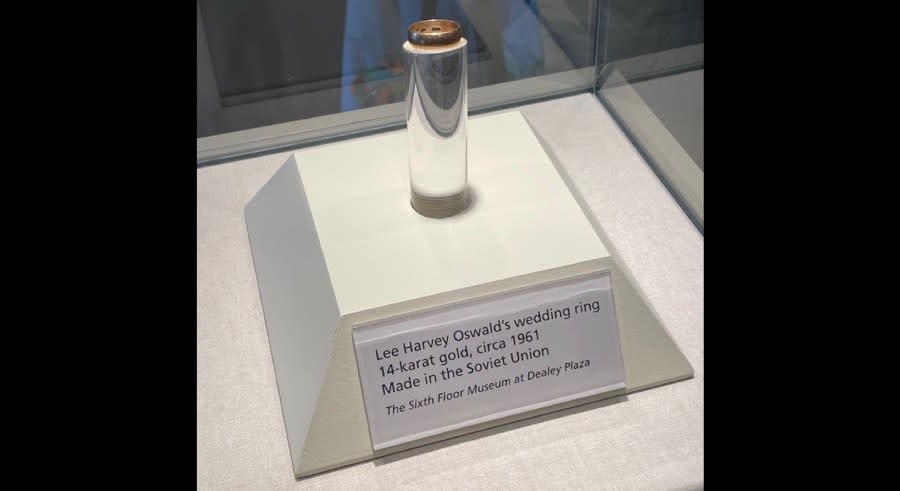60 years later, new documentary colorizes JFK’s final hours
- Oops!Something went wrong.Please try again later.
- Oops!Something went wrong.Please try again later.
DALLAS — Nearly 60 years after his shocking death on a November day here in Texas, the story of President John F. Kennedy’s assassination is being newly told in vivid color by some of the figures who lived through it.
The aim of “JFK: One Day in America,” says producer Charlotte Rodrigues about the three-part series premiering Sunday on National Geographic and streaming the following day on Hulu and Disney+, is to experience the moments in time leading up to and following Kennedy’s death by seeing it “through [witnesses’] eyes in a very visceral and a very emotional way.”
The documentary, from the same team that created the Emmy Award-winning “One Day in America” franchise focused on the Sep. 11, 2001, terror attacks, utilizes archival footage from 1963 that was colorized for the first time.
“We wanted to be able to present the theories and the subject matter to a younger audience and bring it to life in a different way that hadn’t been seen before,” said Alex Nicholson, a production executive with 72 Films, which produced the project for National Geographic.
To colorize one minute of film took an average of one to two days — it took 12 weeks to turn 53 minutes of black-and-white images into ones with color, according to its creators.
Peggy Simpson was working as an Associated Press reporter in 1963 — the only woman in the role at the news organization’s Texas bureau at the time — when her manager had instructed her to “find a single legislator and get a date” in order to finagle her way inside a dinner that Texas Gov. John Connally and Kennedy were poised to attend on the night of Nov. 22.
“I therefore had gotten my hair all done, and I was all gussied up. I still had about six hours to play around with, and my bureau chief said to just go down to the motorcade. So that’s what I did,” Simpson, 84, recalled.
She stopped by to see the presidential motorcade go by and headed back to her office. When she stepped into the newsroom, she heard the receptionist on the phone saying that the president had been struck by a bullet.
“My bureau chief had already put out what is the highest red alert that you can do, which is a flash, and he said, ‘The president’s been shot.’”
“So I just ran out again and went to Dealey Plaza and sort of embedded myself with the cops,” Simpson said.
The veteran journalist would later witness club promoter Jack Ruby shooting Lee Harvey Oswald two days after Kennedy’s death, killing the former Marine who had defected to the Soviet Union as he was being escorted by detectives inside Dallas Police Headquarters.
Rodrigues noted that six decades after Kennedy’s death, some of the last living witnesses to that tragic day are now in their 80s and 90s.
“We felt this was probably going to be the last time that we were going to capture their testimony and we felt it was really important to do that before that wasn’t a possibility anymore,” Rodrigues said.
The documentary, she said, makes the audience “feel like you’re in the POV of the eyewitnesses and it feels like you’re there at that time, in that moment.”
Simpson said she agreed to participate in the National Geographic project after explicitly telling the series’ creators, “I don’t do conspiracy theories.”
“Gallup has determined in polling that there’s never been less than 50 percent of the American public that hasn’t believed in a conspiracy” related to Kennedy’s death, Stephen Fagin, curator of the Sixth Floor Museum, which is located in the Texas School Book Depository building, told ITK.
The Dallas museum, which partnered with National Geographic for “JFK: One Day in America,” doesn’t take a position on the assassination.
“We don’t say Oswald was the lone assassin, but we also don’t say there was a conspiracy,” Fagin said.
The life and death of Kennedy continue to fascinate 60 years later because it was “really was a time of change for this country,” Fagin explained, adding Kennedy “represented something new and different are really at a turning point at the dawn of the 1960s.”
“For this man, so young, with his beautiful family who had been on television, such a perpetual presence in American lives and pop culture icons,” he said, “for all of that to culminate in a very public, graphic murder just sees the nation and the world in a manner that they had not witnessed before.”
“It was a moment that really defined the nation and the world,” he said.
Leading up to the debut of the documentary, National Geographic took reporters on a promotional trip paid for by the network to Fort Worth and Dallas to retrace Kennedy’s steps before he was killed on Nov. 22, 1963.
Arrival at Hilton

President John F. Kennedy attends a breakfast hosted by the Fort Worth Chamber of Commerce, in Fort Worth, Tex., Nov. 22, 1963. (AP Photo/Ferd Kaufman)
President Kennedy stayed at the former Hotel Texas, now the Hilton Fort Worth, on Nov. 21, 1963, before attending a breakfast held by the Chamber of Commerce in the hotel’s ballroom the next morning.
His final meal at the meeting included boiled eggs, bacon, toast with marmalade, with orange juice and coffee.
While Kennedy slept in room on the hotel’s eighth floor, today the space features a suite on a top floor inspired by the commander in chief and inspired by the White House’s look during his presidency.
Ruth Paine House

Ruth Paine’s house in Irving, Texas, which is now a museum. (Judy Kurtz)
Oswald spent the night before Kennedy’s assassination at the Irving, Texas, home of his wife Marina’s friend, Ruth Paine. The home has been restored to how it looked in 1963, with projected images telling the stories of its residents and the house’s tragic connection to Kennedy’s accused killer.
Dealey Plaza

Dealey Plaza in Dallas. (Judy Kurtz)
While much has changed in the world — and the Lone Star State — since 1963, the design of Dallas’s Dealey Plaza has remained virtually untouched. A white “X” can be seen on the street, marking the exact location where Kennedy was shot while traveling in his motorcade to a luncheon. The shooting also injured Connally and James Tague, a bystander. Oswald was also charged with killing J.D. Tippit, a Dallas police officer, on the same day as Kennedy’s assassination.
In “JFK: One Day in America,” then-radio reporter Sid Davis reflected on covering the aftermath of the shooting from the Parkland Memorial Hospital in Dallas, before news broke of whether the president was alive or dead.
“All I could think was, get to the hospital, get the story,” Davis said.
Sixth Floor Museum

Lee Harvey Oswald’s wedding ring, that he left on a dresser on the morning of Nov. 22, 1963. (Judy Kurtz)
The boxes, albeit recreations, are still arranged in the same way they were discovered by police in the Texas School Book Depository — the space where authorities accused then-warehouse employee Oswald of firing at Kennedy from a sixth floor window — just minutes after the president was struck.
The building, now a museum, contains artifacts about Kennedy and his death. Some of the displays include an Associated Press typewriter, similar to one that Simpson might have used, and Oswald’s wedding ring, which he left in a cup on a dresser by his wife’s bedside on the morning of the assassination.
Texas Theatre

A promotional poster for National Geographic’s “JFK: One Day in America,” inside the Texas Theatre. (Judy Kurtz)
Officers arrested Oswald inside a movie theater in the afternoon of Nov. 22, 1963.
Every year, the theater, which is still in operation, screens the same movie that was shown during Oswald’s arrest — “War is Hell” — on the anniversary of Kennedy’s assassination.
The theater is where National Geographic premiered “JFK: One Day in America,” ahead of its Nov. 5 release.
Former Dallas Police Dept.
The site of the Dallas Police Department, where Oswald was transported following his arrest, is now the UNT Dallas Law Center.
The room where Oswald was interrogated, as well as a jail cell where both he and Ruby were held, have been preserved.
Although it is not yet open to the public, a video display plays on the wall as guests enter a permanent exhibit.
Enduring Legacy

The JFK Tribute Memorial in Fort Worth, Texas, stands in the same place where President Kennedy gave his last public speech on Nov. 22, 1963. (Judy Kurtz)
“I think there’s always going to be curiosity about the assassination,” Fagin said.
“As of June [2023,] 99 percent of the government files related to the assassination have been released or at least unredacted,” he added.
“Historians and researchers are still poring through millions of pages of documents looking for the answers — and perhaps we’ll learn something new — but as far as there ever being a consensus, I don’t think we’re ever going to reach that point.”
For Simpson, it “feels like a long time” since Kennedy was shot on that November day 60 years ago.
“I wasn’t trying to forget it,” she said.
“You never forget it.”
For the latest news, weather, sports, and streaming video, head to The Hill.

